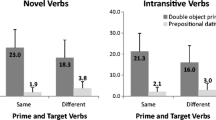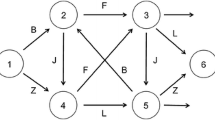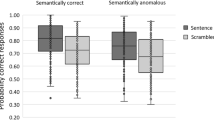Abstract
In order to determine whether mechanically generated sentences, often referred to in the literature as “anomalous,” are in fact anomalous, subjects in the present experiment were asked to do two different tasks: a paired-associates learning task involving anomalous sentences as responses, and a second task in which they were asked to interpret such sentences. These tasks were counterbalanced across different groups of subjects. Results of the interpretation task showed that a large proportion of subjects were able to give interpretations for anomalous sentences, while learning results indicated that anomalous sentences were more difficult to anticipate than natural sentencesonly when task order was Learn first, Interpret second. In the order Interpret-Learn, differences in ease of learning between anomalous and naturally occurring sentences did not appear. The results of this study demonstrate that anomalous sentences are interpretable, that a range of difficulty for such sentences can be established, that anomalous sentences are learned as easily as naturally occurring ones after interpretation, and that many of the interpretations given to such sentences are metaphoric in character. These findings are discussed in terms of their implications for models of lexical organization.
Similar content being viewed by others
References
Barclay, J. R., Bransford, J. D., Franks, J. J., McCarrell, N. S., and Nitch, K. (1974). Comprehension and semantic flexibility.J. Verb. Learn. Verb. Behav. 13:471–481.
Bickerton, D. (1969). Prolegomena to a linguistic theory of metaphor.Found. Land. 5:34–52.
Burns, B. (1975). Some psychological aspects of anomalous sentences. Unpublished M.A. thesis, University of Tennessee, Knoxville.
Epstein, W. (1969). Recall of word lists following learning of sentences and of anomalous and random strings.J. Verb. Learn. Verb. Behav. 8:20–25.
Epstein, W. (1972). Long term memory for sentences, anomalous sequences and random strings.Am. J. Psychol. 85:21–30.
Johnson, M. G. (1972). Language, flexibility and theories of meaning. Paper presented at 1972 meetings of Psychonomic Society, St. Louis.
Katz, J. J. (1967). Some remarks on Quine on analyticity.J. Philos. 64:36–52.
Katz, J. J. (1971).The Underlying Reality of Language and Its Philosophical Impact, Harper and Row, New York.
Katz, J. J., and Fodor, J. A., (1963). The structure of a semantic theory.Language 39:170–210.
Leech, G. (1974).Semantics, Penguin, Middlesex.
Marks, L. E., and Miller, G. A., (1964), The role of semantic and syntactic constraints in the memorization of English sentences.J. Verb. Learn. Verb. Behav. 3:1–5.
Marton, F. (1970).Structural Dynamics in Learning, Almqvist and Wiksell, Stockholm.
Meyer, D. E. (1970). On the representation and retrieval of stored semantic information.Cogn. Psychol. 1:242–300.
Miller, G. A. (1965). Some preliminaries to psycholinguistics.Am. Psychologist 20:15–20.
Miller, G. A., and Isard, S. (1963). Some perceptual consequences of linguistic rules.J. Verb. Learn. Verb. Behav. 2:217–228.
Percy, W. (1958). Metaphor as mistake.Sewanee Rev. 66:79–99.
Pollio, H. R., Linder, W., and Foote, R. (1973). Process-governed changes in the temporal properties of ordered recalls.Scand. J. Psychol. 14:114–120.
Pollio, M. R., and Pollio, H. R. (1974). The development of figurative language in children.J. Psycholing. Res. 3(3:185–201.
Sharp, C. J. (1932). (ed., Maude Karpeles)English Folksongs from the Southern Appalachians, Vol. 2, Oxford University Press, London.
Steinberg, D. (1970). Analyticity, amphigory, and the semantic interpretation of sentences.J. Verb. Learn. Verb. Behav. 9:37–51.
Steinberg, D. (1972). Truth, amphigory, and the semantic interpretation of sentences.J. Exp. Psychol. 93:217–218.
Tulving, E., and Thompson, D. M. (1973). Encoding specificity and retrieval processes in episodic memory.Psychol. Rev. 80:352–373.
Verbrugge, R. R. (1974). The comprehension of analogy. Unpublished doctoral dissertation, The University of Minnesota, Minneapolis.
Author information
Authors and Affiliations
Rights and permissions
About this article
Cite this article
Pollio, H.R., Burns, B.C. The anomaly of anomaly. J Psycholinguist Res 6, 247–260 (1977). https://doi.org/10.1007/BF01068023
Received:
Issue Date:
DOI: https://doi.org/10.1007/BF01068023




